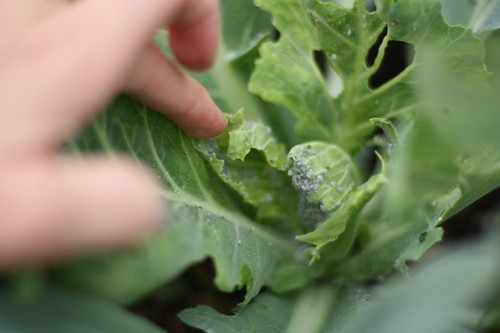

I know what you are saying to yourself right about now, “Oh, I wish Scott & Kendra would invite me over for some cabbage soon, it’s looks so delicious.” Or you might be wondering, “Is it National Gross-Out Week on A Sonoma Garden?” Isn’t this awful?
If you ever wanted to know how to improve as a gardener I would say the first thing to do is to take regular early morning walks out in your garden. As the saying goes, ‘The best fertilizer a gardener can use is his own footsteps.’ Those early morning walks is when you’ll catch all the creepy crawlies that are harming your crops. I had been wondering what was eating our cabbage. I knew about the aphids, but I didn’t know about what was taking those big bites.
The other morning I was looking for something more creative to do with the boys than watch early morning cartoons so I bundled us all up and sent us outside. And these cabbage worms are what we found. Cabbage worms can grow up to about two inches long and are green with a slim yellow line down them. Apparently some sort of white butterfly found our cabbage and laid her eggs on the underside of the leaves which then hatched into these pesky critters.
You can get rid of cabbage worms by:
- Applying BT (Bacilulus thuringiensis), which is a naturally occuring bacteria that is harmless to us, but deadly to the cabbage worms.
- Applying a hot pepper spray (which you can make yourself with ground up 1/2 cup of hot peppers into 1 pint of water) every four to five days
- Applying insecticidal soap which is a plant derived concoction that dries up the worm. Try this one:
Bon-Neem Insecticidal Soap – Quart RTU
- Or you can simply hand pick them
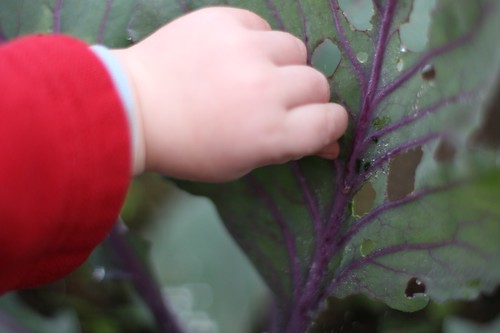
We opted for the hand picking method. Thank goodness for little boys who have no qualms about picking them up. Our oldest decided that they needed a new home so he promply brought them into his room. I thought maybe they would be best kept in a jar rather than crawling free for all on his bed.
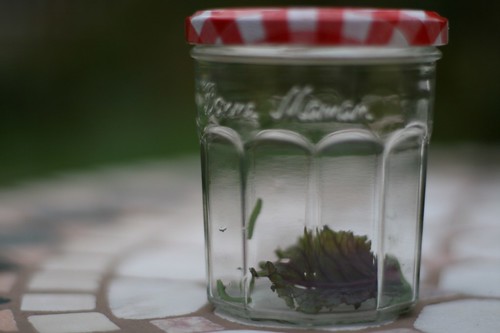
Now we need to work on those aphids. This isn’t our first problem with aphids. We normally haven’t had too much of a problem from them, but this year they seem to really like our yard, remember the kale carnage?. Oh the horrors!


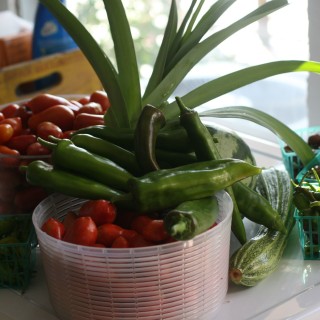
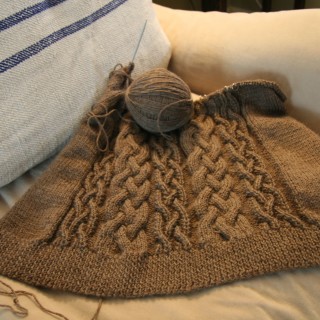
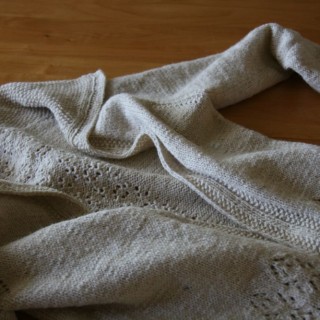



I’m glad you posted that picture of the aphids (though it wouldn’t let me enlarge it). I have wondered what they looked like. I love the chubby little hand picking off the wormies.
I had these on collard plants earlier this year! Half the plants were gone before I discovered them and picked them off. Thanks for the list of remedies.
Hey Gardenmama, you ‘should’ be able to see the photo closer if you click on through to flickr. Then right above the photo will be an ‘all sizes’ button. Click on that. Basically they just look like little gray/green oval bugs though.
Diana, those worms eat fast! I can believe that they wiped out your kale before you found them! Hopefully those remedies will help you next year. Kale is worth saving…so tasty!
We squish and collect cabbage moth caterpillars too – so it was that we first discovered they were being parasitised by wasps; my boys collected them in a jar and as we watched we saw them erupt with tiny larvae which then spun cocoons and pupated on the dead body of the caterpillar! After about 2 wks the pupae hatched into tiny wasps. Very cool We’ve since found a lot of the wasp pupae through the brassicas, and they seem to keep the cabbage moth caterpillars under control. We plant a lot of predator-food through the garden to feed the wasps and other beneficials, so it seems to be working. It’s lovely to see
We’ve since found a lot of the wasp pupae through the brassicas, and they seem to keep the cabbage moth caterpillars under control. We plant a lot of predator-food through the garden to feed the wasps and other beneficials, so it seems to be working. It’s lovely to see 
those darn aphids get my cauliflower, cabbage and broccoli every year! I’m almost to the point of not planting those anymore. I read somewhere that if you cover your seedlings with a breathable mesh cloth while the white moths are flying around looking for places to lay their eggs- you may be able to avoid them. Haven’t tried it yet- if I ever do I’ll let you know.
I’ve been battling the cabbage worm too and they’re winning. I’m going to try BT.
I had the aphid scenario with my cabbages last year. I was still able to harvest some heads for sauerkraut as long as I removed a bunch of outside leaves before making the heads into “kraut”.
I later learned that my grandmother used to sprinkle wood ash over her cabbages to prevent the white “butterflies” from laying eggs for cabbage worms and also to curtail an aphid infestation. Apparently, it did not affect the taste or quality of the cabbage.
I’m planning on dusting this year’s crop with ash from my wood burning stove once they’ve become established. If I need to, I’ll follow up with a second or more dusting as the season progresses.
I’ll let you know what happens.
ohhhh Lizzie, great tip about the wood ash. I’m sitting in front of our fireplace now looking at those ashes. We’re done with cabbage planting for this season, but I’ll come back to this tip for next year! Thanks.
My friend told me 2/11/10,that if you eat cabbage and a cabbage worm is in there,it will kill you.Now I’m thinking,I have probably eaten a cabbage worm,and I’m not dead.Is she talking about another kind of cabbage worm? I was scared to pieces. Please let me know!
I’m going to try a butterfly net this year along with my first attempt with row covers…